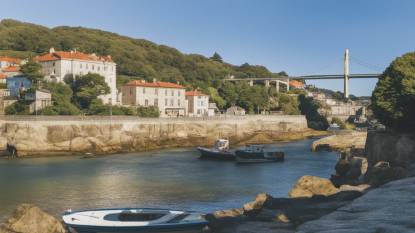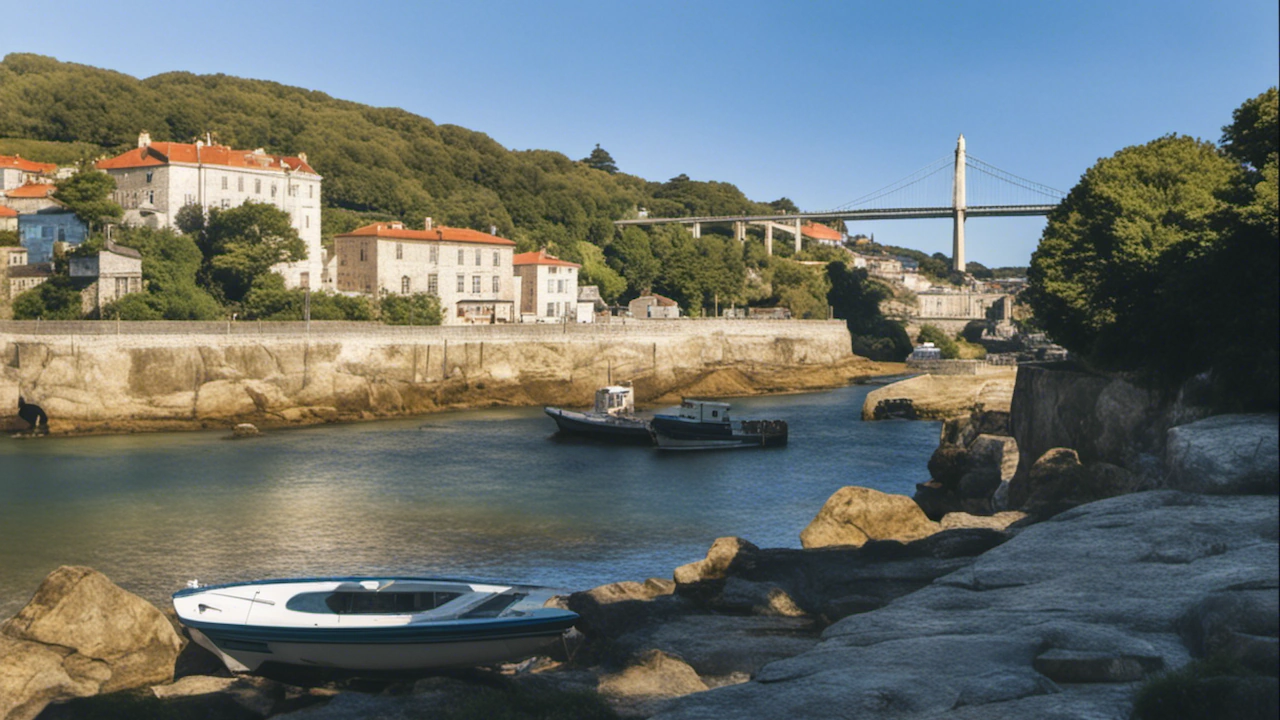
Camino Inglés: Pontedeume to Betanzos - Stage 3
Posted: | Updated:
Reading time: 11 minutes
Camino Inglés: Pontedeume to Betanzos - Stage 3
Posted: | Updated:
Reading time: 11 minutes
By: Simon Kemp, Editor
Embarking on a journey that spans approximately 20 kilometers or 12.5 miles , pilgrims navigating from Pontedeume to Betanzos on the Camino Inglés are treated to a rich tapestry of experiences that seamlessly weave through varied landscapes and historical echoes. Starting in Pontedeume, a town bathed in historical resonance with its medieval structures and cobblestone streets, walkers are gently introduced to the Camino’s distinctive blend of cultural exploration and physical journeying.
As pilgrims proceed, the iconic River Miño emerges as a notable landmark, its expansive bridge not only providing a physical conduit to the town of Miño but also symbolizing a transition from urban to more natural terrains. The views from the bridge, where tranquil waters meander through lush banks, afford a moment of serene reflection and an opportunity to immerse oneself in the natural beauty that characterizes much of the Galician landscape.
Venturing further, the route delves into the peaceful embrace of serene forests, where the sounds of civilization are replaced by the gentle rustling of leaves and the distant calls of indigenous bird species. These forests, an epitome of Galician nature, not only offer a cooling respite from the sun-dappled paths but also a mental sanctuary amidst the physically engaging trek. The lush green canopy and the soft, earthen trails underfoot encapsulate a quintessential Camino experience, balancing physical exertion with soulful rejuvenation.
Concluding this stage, the descent into Betanzos reveals a town where the past and present coalesce, with medieval architectural gems punctuating the urban sprawl. Betanzos, with its richly historic squares and aged structures, invites pilgrims to step back in time, exploring a preserved tapestry of a bygone era and perhaps reflecting on the timeless nature of the pilgrimage itself.
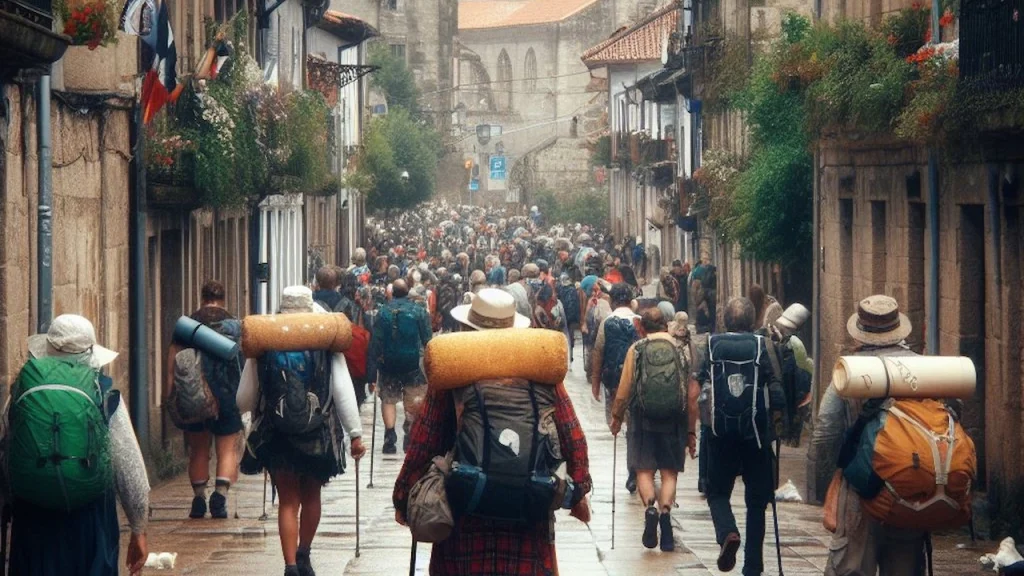
Throughout this segment, the terrains converse with each other in a dialogue of contrast — from the urban, through the natural, and into the suburban, each presenting its unique challenges and delights. The upward challenges post-Pontedeume and the careful navigation through potentially slippery forest paths require a certain degree of physical preparedness and mindful walking. Yet, these exertions are mitigated by the available rest opportunities, notably in the welcoming environs of Miño and the endpoint of Betanzos, each offering a pause for physical recovery and contemplative relaxation amidst their respective charms.
In essence, the Pontedeume to Betanzos stage represents a microcosm of the Camino Inglés journey: a path that integrates varied landscapes, historical narratives, and the perpetual interplay between movement and stillness, guiding pilgrims through an exploration of both external environments and internal landscapes.
Map of Pontedeume to Betanzos
Departure point: Pontedeume
Embraced by the luscious Galician landscapes and kissed by the gentle Eume River, Pontedeume presents a mosaic of medieval charm, vibrant local culture, and tranquility to every visitor.
Perfectly nestled between Ferrol and A Coruña on the Camino Inglés, this delightful town extends a picturesque pause for pilgrims and travelers, inviting exploration and rest.
With its harmonious blend of history, culture, and natural allure, Pontedeume offers a tapestry of memories and experiences that resonate with visitors, ensuring each step taken within its confines echoes with the rich, timeless spirit of the town.

Historical Context
- Medieval Vibrations: The town, richly infused with stories from the medieval era, prominently features the Andrade family and their stately 14th-century tower, offering a tangible link to Pontedeume’s noble past.
- Bridge of Ages: Pontedeume’s iconic medieval bridge, while reduced from its original size, creates pathways through time, connecting travelers to history as they cross.
Prominent Attractions
- Torreón de los Andrade: This resilient tower is a visual anchor to Pontedeume’s medieval narrative, providing visitors a gateway to explore the noble tales of the Andrade family.
- Fragas do Eume: This expansive park invites you to immerse yourself in nature, journeying through forests that whisper ancient tales, and along the Eume River, which has carved its way through history and terrain.
Pilgrim Amenities
- Stay Options: From the friendly embrace of Albergue-Pensión As Hortas to intimate family-run pensions, Pontedeume offers pilgrims a variety of cozy and welcoming stay options.
- Gastronomic Delights: Through its quaint cafés and bustling tapas bars, Pontedeume invites travelers on a culinary adventure through the fresh and vibrant flavors of Galicia.
Cultural Threads
- Feira Medieval: Pontedeume’s annual medieval fair is a lively display of historical trades, traditional crafts, and dynamic performances, reflecting and celebrating the town’s rich historical and cultural roots.
Natural Enchantments
- Atlantic Beaches: Pontedeume unfolds into the Atlantic, presenting tranquil beaches that offer a peaceful counterpart to its forested areas.
- Nature Paths: Inviting paths, ranging from peaceful river walks to more adventurous forest expeditions, draw explorers into Pontedeume’s enchanting natural worlds.
Experiences from Pilgrims
- Voice of the Traveler: One pilgrim shares, “In Pontedeume, ancient narratives are gently whispered by the stones and trees, providing a thoughtful pause and reflection in our pilgrimage.”
Practicalities
- Reaching Pontedeume: With its strategic location and accessible transport links, reaching Pontedeume is straightforward for pilgrims and tourists alike.
- Optimal Visit Times: Though summer brings a vibrant energy, the softer presence of spring and fall reveal a more peaceful and introspective Pontedeume, offering distinct experiences for visitors.
Additional Information
- In-depth Exploration: The tourist office in Pontedeume and resources like “A Pilgrim’s Guide to the Camino Inglés” serve as valuable tools, providing deeper insights and guides for a comprehensive and enriching journey through the town.
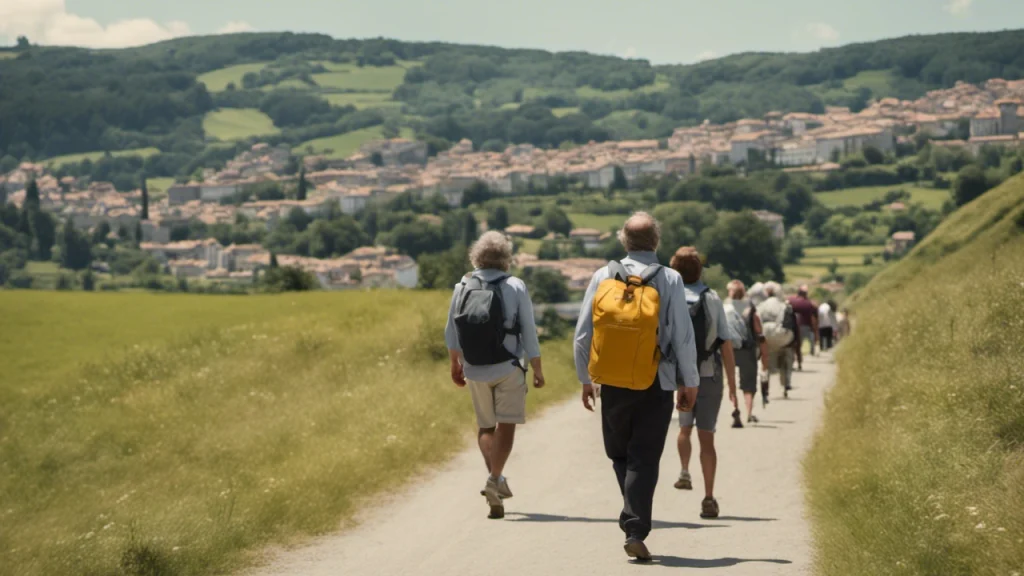
A. Detailed Breakdown of the Route
Spanning around 20km or 12.5 miles, the stage from Pontedeume to Betanzos within the Camino Inglés guides pilgrims from a historic town, across an iconic river, through serene forests, and into a medieval-tinged destination.
This segment amalgamates urban, natural, and suburban terrains with notable elevational changes, providing varied experiences and encounters with both historical and natural points of interest. The journey demands moderate physical exertion, due to certain uphill and forest trail navigations, but furnishes rest opportunities in Miño and Betanzos.
1. Start in Pontedeume:
Beginning amidst the medieval splendor of Pontedeume, pilgrims traverse its historical streets, exploring archaic stone structures and perhaps admiring the Tower of Andrade one last time. The route takes a turn towards a countryside ascension, transitioning from cobbled streets to natural paths.
2. Miño Crossing:
After a scenic walk, the route presents the River Miño and its prominent bridge. This crossing serves not only as a physical passage between Pontedeume and Miño but also as a metaphorical journey from one landscape to another. Views from the bridge grant pilgrims serene moments with the sight of calm waters and lush riverbanks.
3. Bosom of Nature:
Enveloping tranquility comes forth as pilgrims navigate through verdant forests and tranquil agricultural terrains. The sound of rustling leaves and distant birdsong becomes the journey’s soundtrack, providing mental repose amidst the physical activity.
4. Arrival in Betanzos:
Winding down from the natural surroundings, the pathway leans into Betanzos – a town where medieval architecture whispers tales of bygone eras. Pilgrims descend into the town, meeting vibrant squares and welcoming local eateries.
Changes in Terrain and Elevation
The stage offers a balanced mix of terrains: starting with urban paths in Pontedeume, leading through nature-infused trails, and concluding with suburban roads in Betanzos. An uphill challenge awaits post-Pontedeume, followed by fairly even terrains, and ending with a downhill slope into Betanzos.
Points of Interest Along the Route
1. Historical Sites:
Betanzos invites historical exploration, where structures from medieval times offer insights into the town’s vibrant past and cultural heritage.
2. Natural Features:
The Galician forests, with their rich greenery and tranquil atmospheres, provide a refreshing segment for mental and visual respite.
3. Local Landmarks:
The Miño Bridge not only connects lands but also offers an elegant structure and captivating views, providing a brief interlude for contemplation.
Potential Challenges or Difficulties
Navigating the uphill departure from Pontedeume might be taxing for some, requiring a steady and persistent pace. The forest trails, especially during or after rainfall, may present navigational challenges or slippery sections, demanding cautious trekking.
Opportunities for Rest Stops
Miño presents itself as a peaceful rest stop, allowing pilgrims to recharge amidst the journey. Upon arrival in Betanzos, a multitude of options for dining, relaxation, and accommodations welcome weary travelers, offering Galician hospitality and local cuisine.
The Pontedeume to Betanzos stage encapsulates a versatile Camino experience, transitioning through historical urban settings, peaceful natural paths, and culminating in a town echoing with medieval narratives. While the trek offers serene and visually appealing moments, pilgrims should be mindful of the physical demands of elevational changes and potential trail challenges, with restful respites available en route and at the stage’s conclusion.
Public Transportation Options from Pontedeume to Betanzos
There are several public transportation options for travelling from Pontedeume to Betanzos in Spain:
- Train: Renfe Viajeros operates a train from Puentedeume to Betanzos-Ciudad 5 times a day. The journey takes approximately 15 minutes and tickets cost between €4 – €6.
- Bus: MonBus operates a bus from Pontedeume to Betanzos twice daily. The journey takes approximately 35 minutes and tickets cost between €1 – €5.
- Rideshare: There are also rideshare options available which take around 49-59 minutes.
- Taxi or Drive: If you prefer, you can take a taxi or drive from Pontedeume to Betanzos. The distance is approximately 21.3 km or 13 miles and the journey takes around 18 minutes.
Please note that these are estimated times and costs, and actual travel times may vary. It’s always a good idea to check the latest schedules and prices.
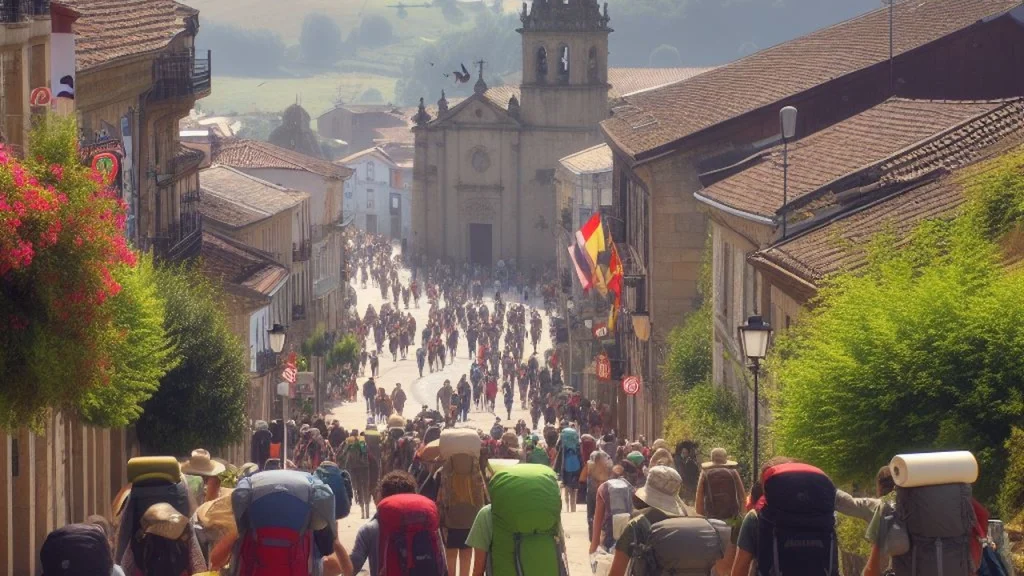
Destination: Betanzos
Exploring Betanzos: A Journey Through Time on thIn the heart of Betanzos, the pilgrims on the Camino Inglés find not just a resting place but a historical, cultural, and natural enclave where the spirit of medieval Galicia is palpably alive, weaving together the physical and spiritual elements of their journey on the Camino Inglés. You will want to stay a while in this wonderful town and enjoy everything it has to offer before you travel onward to the next stop of O Mesón do Vento .
As the Gothic treasure of Galicia, Betanzos invites explorers and pilgrims into its rich tapestry of history, defined by medieval architecture, narrow cobblestone streets, and a profound historical essence. Serving as a serene yet culturally rich halt on the Camino Inglés, it enables travelers to engage with authentic Galician history and tradition while on their pilgrimage to Santiago de Compostela.
Historical Framework
- A Glimpse of the Past: Betanzos thrives as a vibrant reminder of medieval Spain, where every structure from the Church of Santa Maria de Azogue to the historic city walls whispers tales from the bygone era, intermingling the spiritual journey with a historical exploration.
- Historical Significance: Its notable role as a vital port and a focal point in political machinations across various epochs significantly enriched its cultural and architectural heritage, offering a fascinating exploration to visitors.
Key Attractions
- Iglesia de San Francisco: Not merely an architectural masterpiece, this church is a repository of the past, featuring meticulous Gothic craftsmanship, stunning stained glass, and the final resting place of Fernán Pérez de Andrade, a significant figure in medieval Galicia.
- Os Pasatempos Garden: Far beyond a conventional garden, this unusual space reveals stories through its whimsical sculptures and unconventional designs, narrating socio-political commentary while also portraying the creative intellect of its creator, Juan García Naveira.
Services for Pilgrims
- Diverse Accommodations: With options ranging from the traditional and humble Albergue de Peregrinos to more comfortable hotels, Betanzos ensures restful nights for travelers, providing amenities that cater to varied preferences and budgets.
- Gastronomic Exploration: Known for the distinctive Tortilla de Betanzos, featuring a deliberately runny center, the town enables travelers to dive into a culinary adventure, exploring authentic Galician flavors in myriad eateries.
Cultural Tapestry
- Festa de San Roque: A vibrant explosion of culture and tradition, the festival represents more than celebration — it is a window into the authentic communal spirit, historical reverence, and lively culture of Betanzos, connecting visitors with local life and traditions.
Surrounding Natural Beauty
- Parque del Pasatiempo: This park, blending nature with art, provides leisurely strolls through its green expanses interspersed with the imaginative vision of its creators, presenting a unique interface between natural tranquility and human creativity.
- Ría de Betanzos: Offering gentle walks alongside the estuary, it provides moments of serenity and reflection, allowing travelers to immerse themselves in the tranquil embrace of nature amidst their journey.
Pilgrim Testimonials
- A Pilgrim’s Perspective: As one pilgrim insightfully shared, “The walls of Betanzos seemed to safeguard stories, legends, and a spirit that seamlessly melded my spiritual quest with a temporal journey through Spain’s vibrant history.”
Practical Information
- Reaching Betanzos: Through its well-connected road networks and available public transport options, reaching Betanzos is conveniently possible for pilgrims and tourists, providing a seamless continuation of their journey.
- Optimal Times to Explore: While summers are alive with festivals, visiting during the spring or autumn unveils a softer, more introspective Betanzos, allowing travelers to explore its beauty amidst mild weather and fewer crowds.
Further Resources
- Enhanced Exploration: The tourist office in Betanzos offers detailed guides, providing additional context and insights to aid explorers in fully engaging with the multifaceted historical and cultural offerings of the town.
- Guide Books: Making use of comprehensive guidebooks, such as “The Pilgrimage Road to Santiago: The Complete Cultural Handbook,” ensures travelers can extract the rich historical and cultural essences embedded within every stop along the Camino Inglés.
